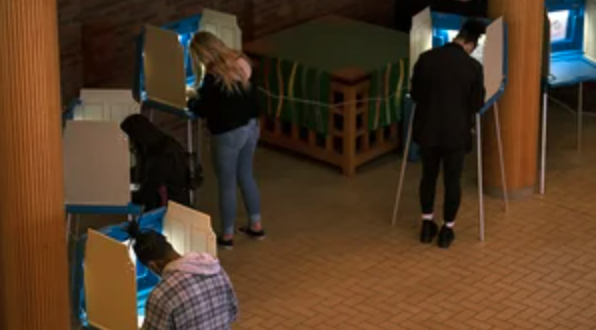
President Biden, the oldest man ever elected to the White House, won on the strength of an emerging cohort of younger voters who are increasingly finding their political voice — and growing their influence in an electorate in which older voters are losing sway.
More members of the millennial generation and Generation Z voted in the 2020 presidential election than in any prior election, according to several studies of the electorate that have taken place in recent months.
And for the first time in American history, a majority of eligible voters under the age of 30 cast a ballot in an election.
As the oldest millennials creep toward their 40th birthdays and more members of Generation Z age into the electorate, the data show those two groups became substantially more powerful within the electorate, as occasional voters cast ballots more regularly and first-time voters began their voting careers in greater proportions.
“Basically 40 percent of the electorate are essentially Gen Z and millennials and some young Xers in there,” said John Della Volpe, director of polling at the Harvard Kennedy School’s Institute of Politics who helped the Biden campaign survey younger voters. “They are replacing the Silent Generation and the Baby Boomers. For every one of those who are exiting the electorate, they are being replaced by someone more progressive.”
About 21 million voters between the ages of 18 and 29 cast a ballot in 2020, up from 18 million in 2016, according to data from the Democratic firm TargetSmart. And 23 million voters between the ages of 30 and 39 cast ballots, an increase of almost 3 million from the last presidential contest.
In both cases, those voters made up a slightly larger share of the overall electorate — up 0.5 percent among 18 to 29-year-olds and up 0.2 percent among 30 to 39-year-olds.
Their gains came as voters between the ages of 40 and 65 declined as an overall share of the electorate. Turnout among 18- to 29-year-olds jumped 9 percent, and by 7 percent among 30- to 39-year-olds. Turnout among those between the ages of 40 and 65 rose 6 percentage points.
“In a pandemic election, where many young Americans found their lives uprooted by college campus closures, the youth vote still expanded over the 2016 benchmark,” said Tom Bonier, TargetSmart’s chief executive.
For the first time, the millennial generation and Generation Z combined to make up a greater share of the electorate than Generation X.
And more of those younger voters are getting more comfortable casting their ballots: Among those between the ages of 30 and 39, almost half are frequent voters, up from just over a third four years ago, a sign that a generation long dismissed for its apathy is engaging in politics more habitually.
There are signs that the emerging younger electorate is likely to provide a windfall for Democratic candidates. In states where voters are allowed to register by party, 52 percent of voters 18 to 29 are registered Democrats, compared with just 35 percent who are registered Republicans. Among 30- to 39-year-olds, the gap is even wider: 53 percent are registered Democrats, while just 34 percent are registered Republicans.
“Young voters were a critical component of the Democratic coalition that formed the Blue Wave in 2018, and will be perhaps even more central to Democratic hopes in the 2022 midterm elections,” Bonier said. “Meanwhile, as the electorate grows increasingly younger and more diverse, Republicans are left clinging to hopes of higher turnout among older and less educated white voters.”
Some Republicans acknowledge the growing generational challenge their party faces.
“The big problem that we have is that we’re not putting forward policy proposals that people are willing to listen to, particularly in those generations,” said Evan Siegfried, the author of “GOP GPS: How to Find the Millennials and Urban Voters the Republican Party Needs to Survive.” “Instead of reacting to proposals and statements by Democrats with mockery and memes, which only appeal to the base and voters you already have, it would benefit Republicans to respond with alternatives and thoughtful debate.”
Siegfried said he is concerned about the lack of a consistent effort to reach out to younger voters, beyond groups like Turning Point USA that hold conferences and forums for already-committed Republican diehards.
“The Millennial Republicans you have now are much more Marjorie Taylor Green than they are Liz Cheney or Adam Kinzinger,” he said.
The growing activism among younger voters goes beyond voting practices. A survey of younger voters that Della Volpe conducted last month found 36 percent of the youngest voters, 18 to 29 years old, described themselves as politically engaged or active, up 12 points since 2009.
That poll found most younger voters are beginning their political lives from a more liberal point on the political spectrum than did previous generations: In the last five years, the percent of younger voters who say government should do more to combat climate change and spend more to reduce poverty, and that basic health insurance is a right, have all increased by double-digit margins.
“There isn’t any generation walking the planet today that voted at a higher level when they were younger than Gen Z and Millennials,” Della Volpe said. “Without Gen Z and Millennials being both highly engaged politically and becoming more supportive of the Democratic Party in the last several years, Nancy Pelosi would not be speaker, Biden would not be president, [Kamala] Harris would not be the tiebreaker” in the Senate.
Via The Hill


